Excerpts from Jim Conrad's
Naturalist Newsletter
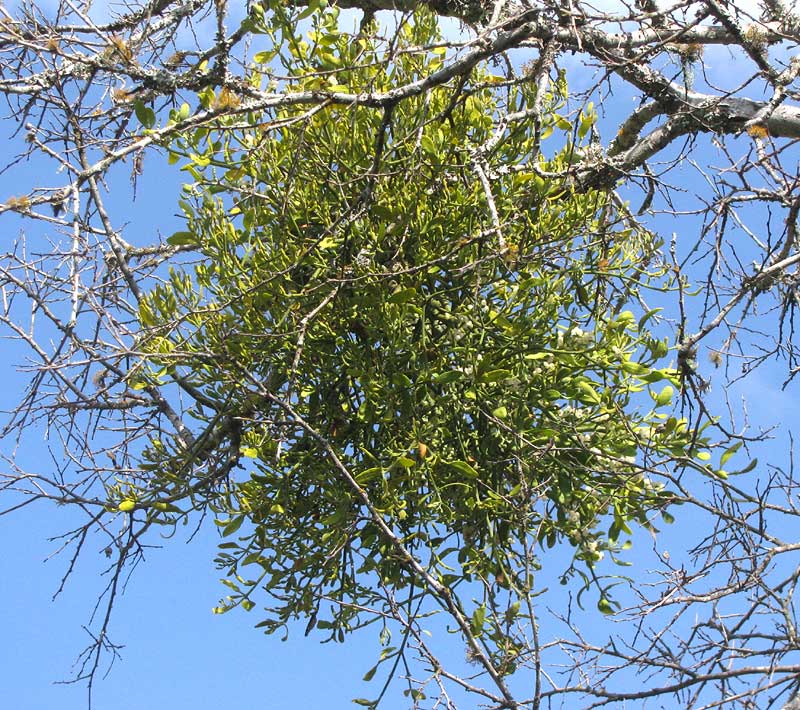
from the December 9, 2012 Newsletter issued from the valley of the Dry Frio River in northern Uvalde County, southwestern Texas, on the southern border of the Edwards Plateau; elevation ~1750m (~5750 ft); N29.62°, W99.86°; USA
MISTLETOE FRUITING
Since the vast majority of our trees are either Ashe Junipers or Texas Live Oaks and these species don't seem to be parasitized by mistletoe, mistletoe isn't as conspicuous in this area as in some. However, there's one occasionally occurring tree species in which most of the mature trees do bear bushel-basket-sized, compact, green clumps of mistletoe, and that's the Cedar Elms. Mistletoe in Cedar Elms is showing up nowadays because the trees have lost most of their leaves. You can see a typical clump in a Cedar Elm above.
A close-up of this misteletoe's pretty fruits is shown below:
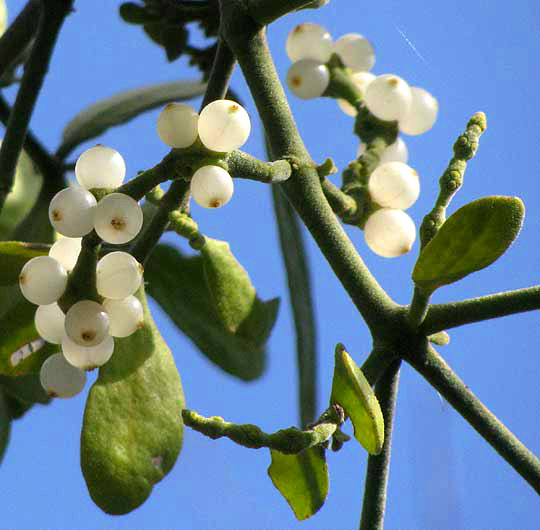
The fleshy, berry-type fruits contain several seeds embedded in very sticky juice. The seeds are dispersed when birds eat the fruit, get seeds stuck to their bills, then fly away and wipe their bills on tree branches, effectively planting the seeds where they can germinate.
Around here people call our mistletoes Christmas Mistletoe. They're PHORADENDRON LEUCARPUM (earlier known as P. tomentosum), which is a different species from the ones commonly seen in eastern North America and along the Pacific coast. Phoradendron leucarpum is mainly distributed in arid northern Mexico, but extends into the US in Texas and parts of Oklahoma and Louisiana.
Phoradendron leucarpum has received attention lately because traditionally in arid northern Mexico it's been used to treat diabetes. In a paper appearing in Proceedings of the Western Pharmacology Society 45: 162-163 (2002) the Mexican researchers state that "... two diabetic patients commented to us that they have been drinking the aqueous extract of this medicinal plant for approximately one year (two glasses daily, 300 ml each) to treat their high levels of blood glucose. With this treatment, they decreased their blood glucose levels to near normal values, and discontinued their medical treatment with oral hypoglycemic agents."
For their research they studied the effects of this "mistletoe tea" on diabetic rats, and found that "... in 45 days the glucose levels of the diabetic animals decreased significantly relative to the diabetic control group, which was treated only with water."
This is pretty exciting information and one wonders why such a simple and inexpensive cure isn't being made available nowadays. You can download the paper for free in PDF format. Find the paper by doing a search on the paper's name, "Preliminary Chronic Toxicological Study of Aqueous Extract of Phoradendron tomentosum."
I'd be careful experimenting with mistletoe teas on my own, however, since the foliage and berries of some mistletoe species are toxic.
from the February 23, 2014 Newsletter issued from the Frio Canyon Nature Education Center in the valley of the Dry Frio River in northern Uvalde County, southwestern Texas, on the southern border of the Edwards Plateau; elevation ~1750m (~5750 ft); N29.62°, W99.86°; USA
MISTLETOE FLOWERING
Mistletoes come in separate male or female plants. The unisexual flowers are tiny and much reduced in structure, as you can see below on some spikes with flowers clustered in rings:
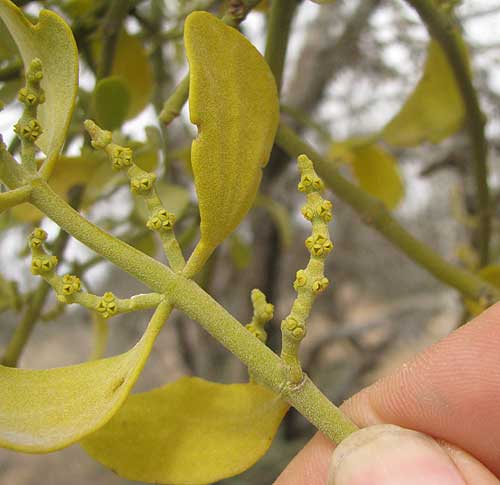
A close-up of three female flowers is shown below:
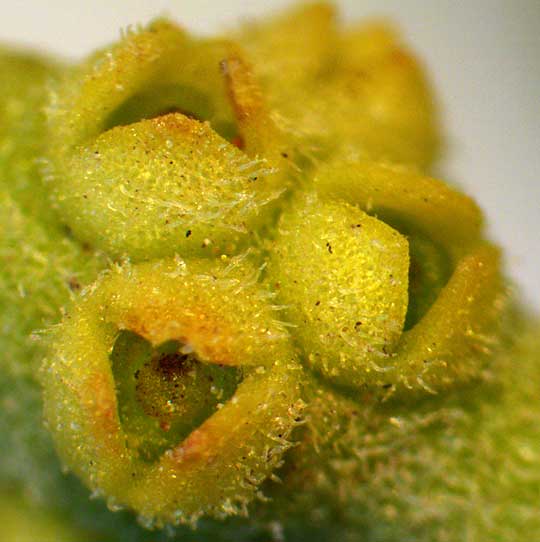
You can see that the flowers have no petals but rather a fairly fleshy, three-lobed calyx forming a deep bowl around the sexual part. At the bottom of each calyx bowl there's a greenish ovary atop which stands a broad, blunt stigma head, which is where pollen from other flowers needs to land and germinate.
I wouldn't have noticed that the flowers were mature and functioning without the help of some flies. Two fly species were "working" the spikes just like a honeybee might, though they didn't appear to be inserting their mouthparts into the calyx bowls. It looked as if they were being attracted to the flowers but couldn't find what they were looking for.
Seeing this, I wondered whether the flowers might be issuing a carrion odor the way some orchids and other plants do, to attract flies to serve as pollinators. I couldn't smell a carrion odor and I've never read that this might be the case.
Back at Juniper House, some Internet browsing informed me that wind and many kinds of insects pollinate mistletoe. Although hundreds of kinds of insects carry mistletoe pollen, only a few dozen are important pollinators; these include a variety of flies, ants, and beetles.
I'm glad to park this observation here so that future researchers will know that in southern Texas in February it sure looks like mistletoe flowers are attracting flies in more than a casual manner.
from the March 2, 2014 Newsletter issued from the Frio Canyon Nature Education Center in the valley of the Dry Frio River in northern Uvalde County, southwestern Texas, on the southern border of the Edwards Plateau; elevation ~1750m (~5750 ft); N29.62°, W99.86°; USA
MALE FLOWERS
Last week we looked at female mistletoe flowers.This week some male plants turned up, and their flowers are shown below:
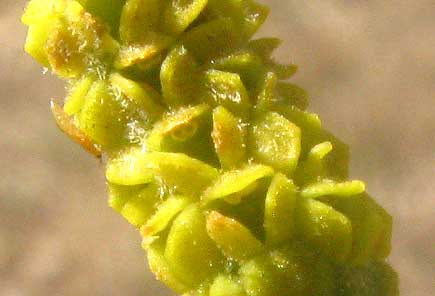
As with the female flowers, male mistletoe flowers bear no petals but rather the sexual parts are enclosed within a fairly fleshy, three-lobed, hairy calyx forming a deep bowl. In the above photo notice the two-chambered, yellow anthers peeking from beneath the calyx lobes arching over them. Each flower produces three stamens topped with pollen-producing anthers, and each stamen is situated directly in front of its calyx lobe.
entry from field notes dated April 15, 2022, taken in disturbed/reforesting borderline cloudforest within 1km of Valle de los Fantasmas, elevation ±2,320m (7600 ft), with limestone bedrock; about 40kms (24 miles), straight-line, ESE of San Luis Potosí, San Luis Potosí state, MÉXICO, (N22.06°, W100.62°)
OAK MISTLETOE IN MEXICO
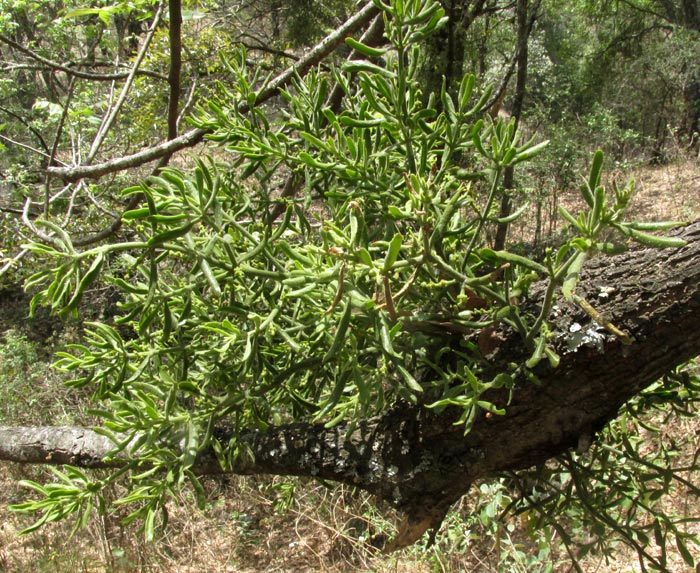
Most North Americans and Europeans, if they know a few of their local native plants, can recognize the above as a mistletoe. It's an evergreen subshrub parasitizing a woody tree, rooting in a tree's woody stem. However, in terms of taxonomy, the whole plant order Santalales, embracing worldwide the four mistletoe families, is a mess, with much disagreement and confusion about mistletoe names and classification, despite modern gene sequencing. Still, most botanists will agree that the above plant, being found in Mexico, belongs to the genus Phoradendron.
Of the about 1400 mistletoe species, Phoradendron contributes approximately 244 species. For the Bajío region, touching San Luis Potosí state on the southern border, the authoritative Flora del Bajío recognizes 20 mistletoe species for that region. Hoping that our mistletoe also will occur in the Bajío, information in the Flora del Bajío was used. Here are some of the main fieldmarks considered.
Parts of the plant are considerably densely hairy, the hairs often branched, or "stellate," and clumping, as shown below:
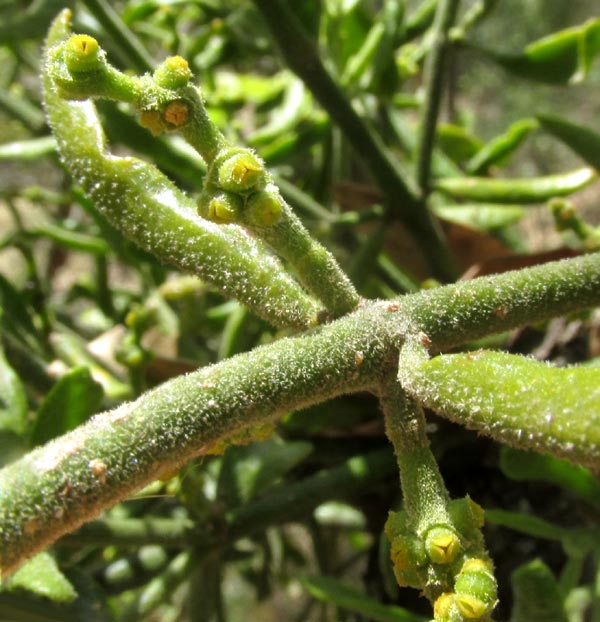
In that picture, the small, spherical "buttons" on the slender item pointing toward the picture's top, left corner are female flowers, the future white, berry-type fruits. Each of these much reduced flowers display three triangular petals. In this species, plants are "dioecious," with male flowers on one plant, female on another. This inflorescence of female flowers displays a certain form that changes somewhat from species to species, and so do the leaves, shown below:
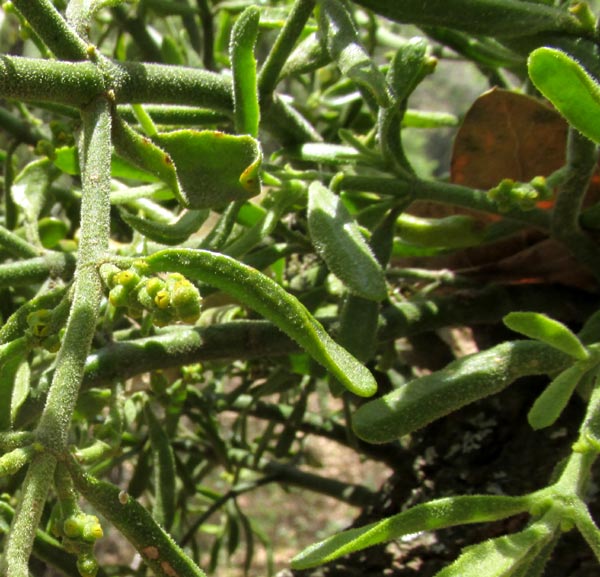
These leaves are considerably narrower than those on most Phoradendron species, so that's a good fieldmark.
Using the Flora del Bajío and comparing our plant with images on the Internet, the above plant works out to be Phoradendron serotinum. However, many but not all taxonomists familiar with the mistletoe situation now consider that name obsolete, merely one of many synonyms of the remarkably wide ranging, highly adaptive species known as Oak or American Mistletoe, PHORADENDRON LEUCARPUM.
Oak Mistletoe as currently understood is distributed from most of the southern half of the US south through northern Mexico to the Bajío region of central Mexico, in northern Guanajuato and Querétaro states. The Flora del Bajío recognizes a narrow bladed subspecies and a broad-leafed one, but the Flora of North America considers those just intergrading variations with no taxonomic significance. This explains why the leaves of our Mexican plant can be much narrower than those we've earlier seen on the species in Texas. In San Luis Potosí we're at the southernmost extreme of this species' large distribution area.
The Flora of North America reports that Phoradendron leucarpum parasitizes over 60 species of native US and introduced trees. Among those listed are walnut, and our mistletoe grew on the stems of a Mexican Walnut, Juglans mollis.
Since mistletoes are such peculiar plants, you can be sure that they've been used traditionally for various medicinal and ritual purposes. More recently, a 2011 study by María del Rosario Jacobo-Salcedo and others, published under the title of "Antimicrobial and cytotoxic effects of Mexican medicinal plants" found that Phoradendron serotinum, now lumped into our current Phoradendron leucarpum, "exerted the highest toxic effects on MCF-7 and HeLa, respectively, which are human cancer cell lines." She suggested that the plant may be an important source of antimicrobial and cytotoxic agents.